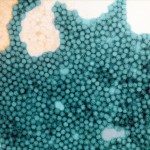Lien vers Pubmed [PMID] – 8389907
J. Virol. 1993 Jul;67(7):3808-17
Most poliovirus (PV) strains, including PV PV-1/Mahoney, are unable to cause paralysis in mice. Determinants for restriction of PV-1/Mahoney in mice have been identified by manipulating PV-1 cDNA and located on the viral capsid protein VP1. These determinants consist of a highly exposed amino acid sequence on the capsid surface corresponding to the B-C loop (M. Murray, J. Bradley, X. Yang, E. Wimmer, E. Moss, and V. Racaniello, Science 241:213-215, 1988; A. Martin, C. Wychowski, T. Couderc, R. Crainic, J. Hogle, and M. Girard, EMBO J. 7:2839-2847, 1988) and of residues belonging to the N-terminal sequence located on the inner surface of the protein shell (E. Moss and V. Racaniello, EMBO J. 10:1067-1074, 1991). Using an in vivo approach, we isolated two mouse-neurovirulent PV-1 mutants in the mouse central nervous system after a single passage of PV-1/Mahoney inoculated by the intracerebral route. Both mutants were subjected to two additional passages in mice, plaque purified, and subsequently characterized. The two cloned mutants, Mah-NK13 and Mah-NL32, retained phenotypic characteristics of the parental PV-1/Mahoney, including epitope map, heat lability, and temperature sensitivity. Mah-NK13 exhibited slightly smaller plaques than did the parental virus. The nucleotide sequences of the mutant genomes were determined, and mutations were identified. Mutations were independently introduced into the parental PV-1/Mahoney genome by single-site mutagenesis. Mutated PV-1/Mahoney viruses were then tested for their neurovirulence in mice. A single amino acid substitution in the capsid proteins VP1 (Thr-22–>Ile) and VP2 (Ser-31–>Thr) identified in the Mah-NK13 and Mah-NL32 genomes, respectively, conferred the mouse-virulent phenotype to the mouse-avirulent PV-1/Mahoney. Ile-22 in VP1 was responsible for the small-plaque phenotype of Mah-NK13. Both mutations arose during the first passage in the mouse central nervous system. We thus identified a new mouse adaptation determinant on capsid protein VP1, and we showed that at least one other capsid protein, VP2, could also express a mouse adaptation determinant. Both determinants are located in the inside of the three-dimensional structure of the viral capsid. They may be involved in the early steps of mouse nerve cell infection subsequent to receptor attachment.
